brake fluid CADILLAC SEVILLE 1996 4.G Owners Manual
[x] Cancel search | Manufacturer: CADILLAC, Model Year: 1996, Model line: SEVILLE, Model: CADILLAC SEVILLE 1996 4.GPages: 354, PDF Size: 20.21 MB
Page 95 of 354
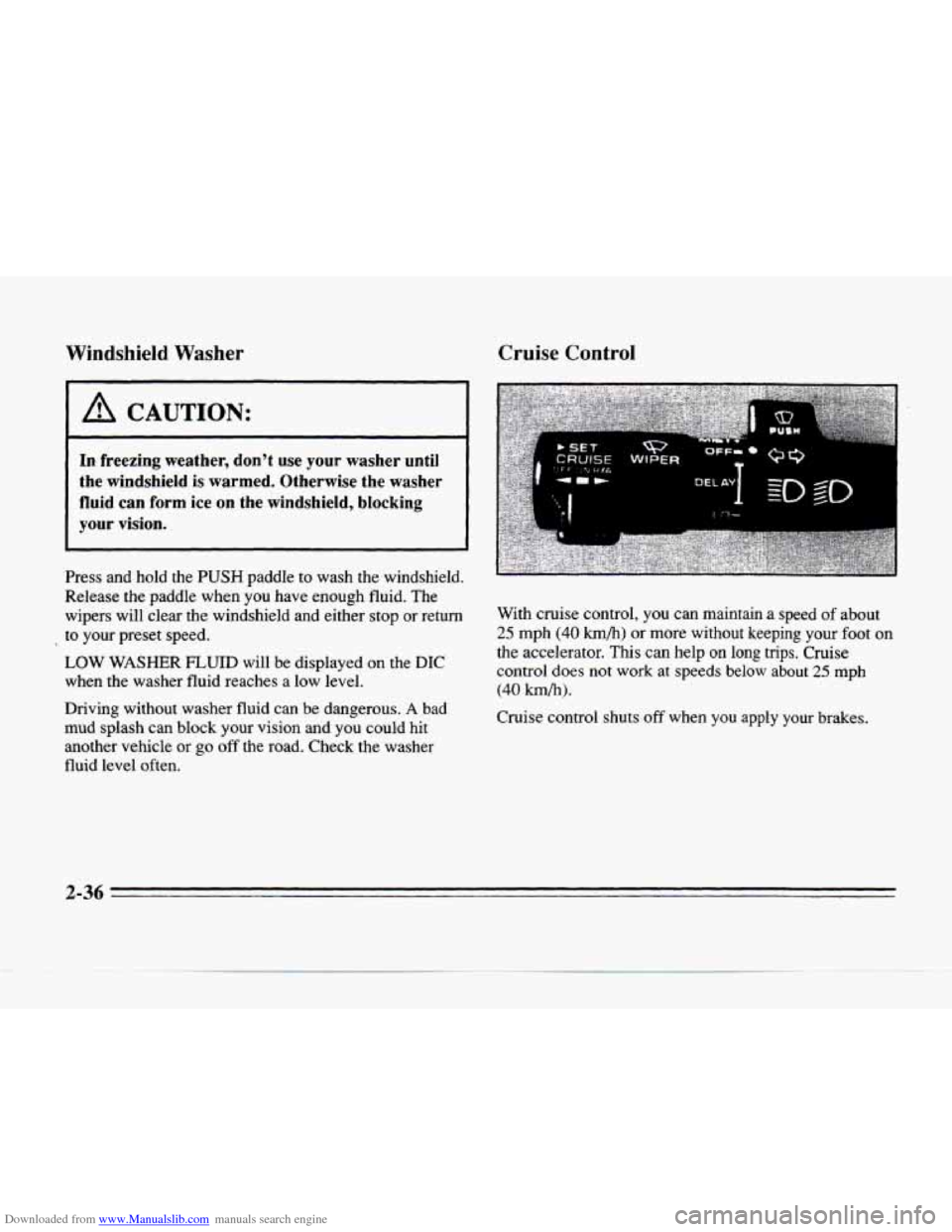
Downloaded from www.Manualslib.com manuals search engine Windshield Washer
I A CAUTION:
In freezing weather, don't use your washer until
the windshield is warmed. Otherwise the washer
fluid can form ice on the windshield, blocking
your vision.
Press and hold the PUSH paddle to wash the windshield.
Release the paddle when you have enough fluid.
The
wipers will clear the windshield and either stop or return
to your preset speed.
LOW WASHER FLUID will be displayed on the DIC
when the washer fluid reaches a low level.
Driving without washer fluid can be dangerous.
A bad
mud splash can block your vision and you could hit
another vehicle
or go off the road. Check the washer
fluid level often.
Cruise Control
With cruise control, you can maintain a speed of about
25 mph (40 h/h) or more without keeping your foot on
the accelerator. This can help on long trips. Cruise
control does not
work at speeds below about 25 mph
(40 km/h).
Cruise control shuts off when you apply your brakes.
2-36
Page 140 of 354
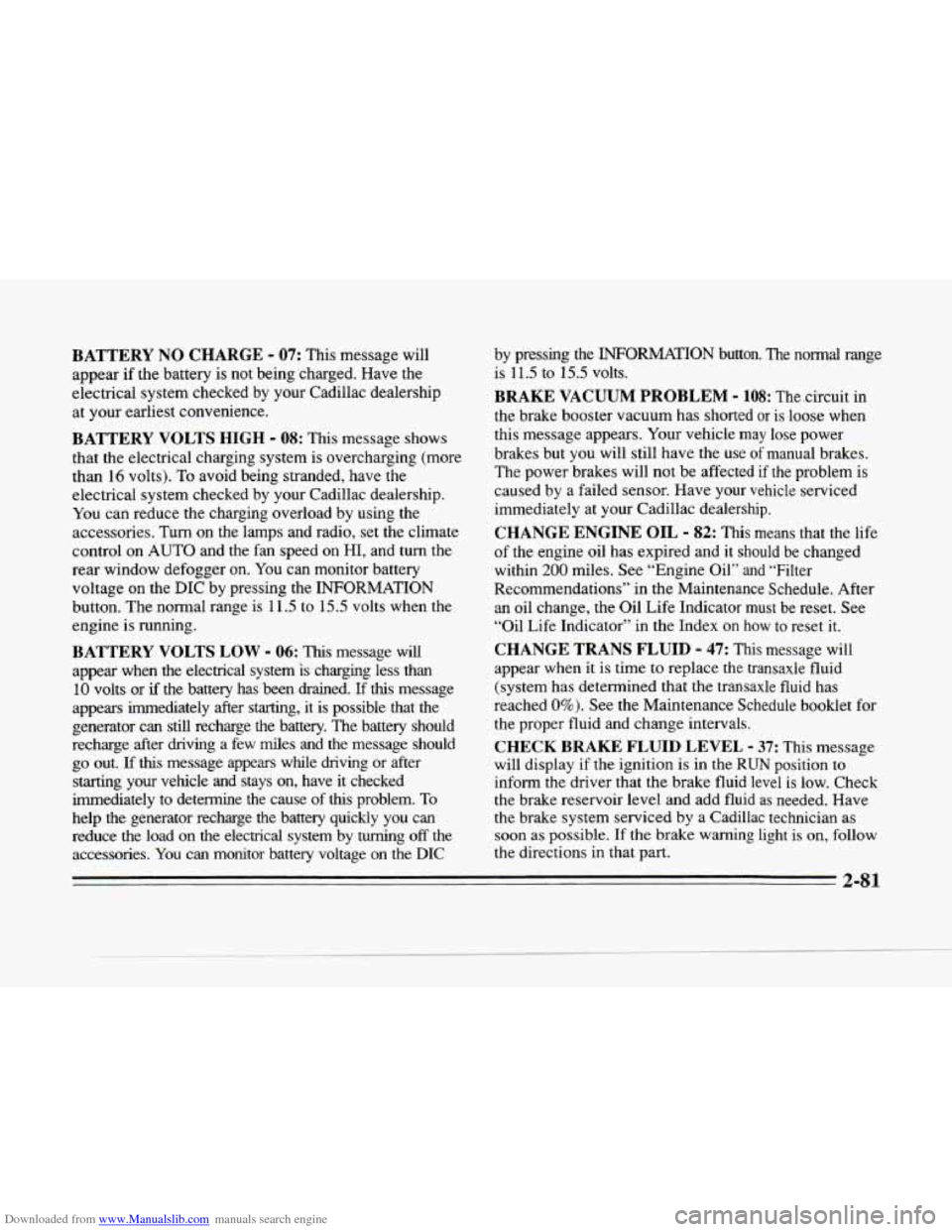
Downloaded from www.Manualslib.com manuals search engine P
c
BATTERY NO CHARGE - 07: This message will
appear if the battery is not being charged. Have the
electrical system checked by your Cadillac dealership
at your earliest convenience.
BATTERY VOLTS HIGH - 08: This message shows
that the electrical charging system is overcharging (more
than 16 volts).
To avoid being stranded, have the
electrical system checked by your Cadillac dealership.
You can reduce the charging overload by using the
accessories. Turn on the lamps and radio, set the climate
control on
AUTO and the fan speed on HI, and turn the
rear window defogger on. You can monitor battery
voltage on the
DIC by pressing the INFORMATION
button. The normal range
is 11.5 to 15.5 volts when the
engine is running.
BATTERY VOLTS LOW - 06: This message will
appear when the electrical system
‘is charging less than
10 volts or if the battery has been drained. If this message
appears immediately after starting,
it is possible that the
generator can still recharge the battery. The battery should
recharge after driving a few
miles and the message should
go out.
Lf this message appears while driving or after
starting your vehicle and stays on, have it checked
immediately to determine the cause
of this problem. To
help the generator recharge the battery quickly you can
reduce the load on the electrical system by turning
off the
accessories.
You can monitor battery voltage on the DIC
by pressing the INFORMA’TION button. The normal range
is 11.5 to
15.5 volts.
BRAKE VACUUM PROBLEM - 108: Thecircuit in
the brake booster vacuum has shorted
or is loose when
this message appears. Your vehicle
may lose power
brakes but you will still have the
use of manual brakes.
The power brakes will not be affected
if the problem is
caused by a failed sensor. Have your vehicle serviced
immediately at your Cadillac dealership.
CHANGE ENGINE OIL - 82: This means that the life
of the engine oil has expired and it should be changed
within
200 miles. See “Engine Oil” and “Filter
Recommendations” in the Maintenance Schedule. After
an oil change, the Oil Life Indicator must be reset. See
“Oil Life Indicator” in the Index
on how to reset it.
CHANGE TRANS FLUID - 47: This message will
appear when it is time
to replace the transaxle fluid
(system has determined that the transaxle fluid has
reached
0%). See the Maintenance Schedule booklet for
the proper fluid and change intervals.
CHECK BRAKE FLUID LEVEL - 37: This message
will display if the ignition is in the
RUN position to
inform the driver that the brake fluid level is low. Check
the brake reservoir level and add
fluid as needed. Have
the brake system serviced by a Cadillac technician as
soon
as possible. If the brake warning light is on, follow
the directions in that part.
2-81
Page 143 of 354
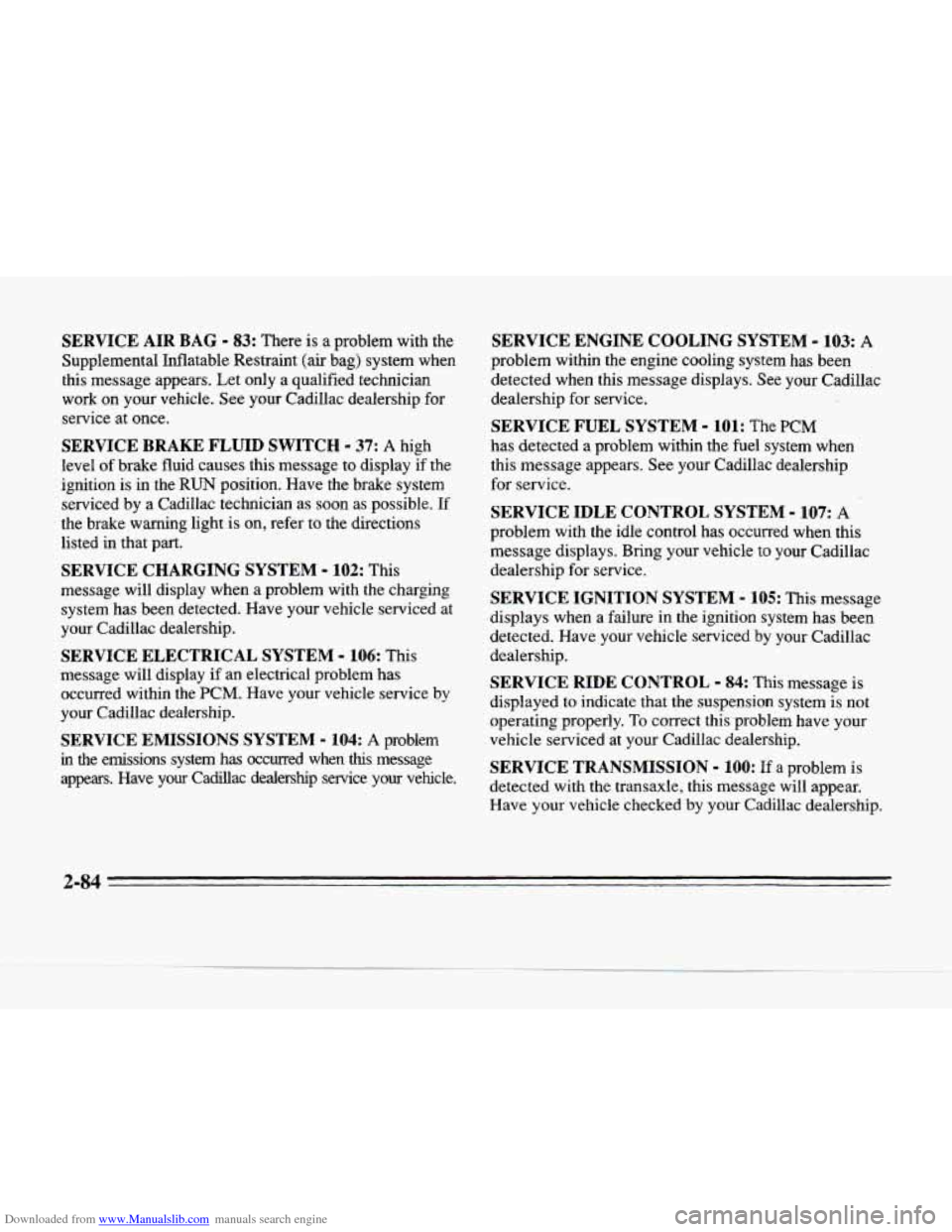
Downloaded from www.Manualslib.com manuals search engine SERVICE AIR BAG - 83: There is a problem with the
Supplemental Inflatable Restraint (air bag) system when
this message appears. Let only a qualified technician
work on your vehicle. See your Cadillac dealership for
service
at once.
SERVICE BRAKE FLUID SWITCH - 37: A high
level
of brake fluid causes this message to display if the
ignition is
in the RUN position. Have the brake system
serviced by a Cadillac technician as soon as possible.
If
the brake warning light is on, refer to the directions
listed in that part.
SERVICE CHARGING SYSTEM - 102: This
message will display when a problem with the charging
system has been detected. Have your vehicle serviced at
your Cadillac dealership.
SERVICE ELECTRICAL SYSTEM - 106: This
message will display
if an electrical problem has
occurred within the PCM. Have
your vehicle service by
your Cadillac dealership.
SERVICE EMISSIONS SYSTEM - 104: A problem
in the emissions system has occurred when thts message
appears. Have your Cadillac dealership service your vehicle.
SERVICE ENGINE COOLING SYSTEM - 103: A
problem within the engine cooling system has been
detected when this message displays. See your Cadillac
dealership
for service.
SERVICE FUEL SYSTEM - 101: The PCM
has detected a problem within the fuel system when
this message appears. See your Cadillac dealership
for service.
SERVICE IDLE CONTROL SYSTEM - 107: A
problem with the idle control has occurred when this
message displays. Bring your vehicle
to your Cadillac
dealership for service.
SERVICE IGNITION SYSTEM - 105: This message
displays when a failure in the ignition system has been
detected. Have your vehicle serviced
by your Cadillac
dealership.
SERVICE RIDE CONTROL - 84: This message is
displayed to indicate that the suspension system is not
operating properly.
To correct this problem have your
vehicle serviced at your Cadillac dealership.
SERVICE TRANSMISSION - 100: If a problem is
detected with the transaxle,'this message will appear.
Have
your vehicle checked by your Cadillac dealership.
2-84
Page 207 of 354
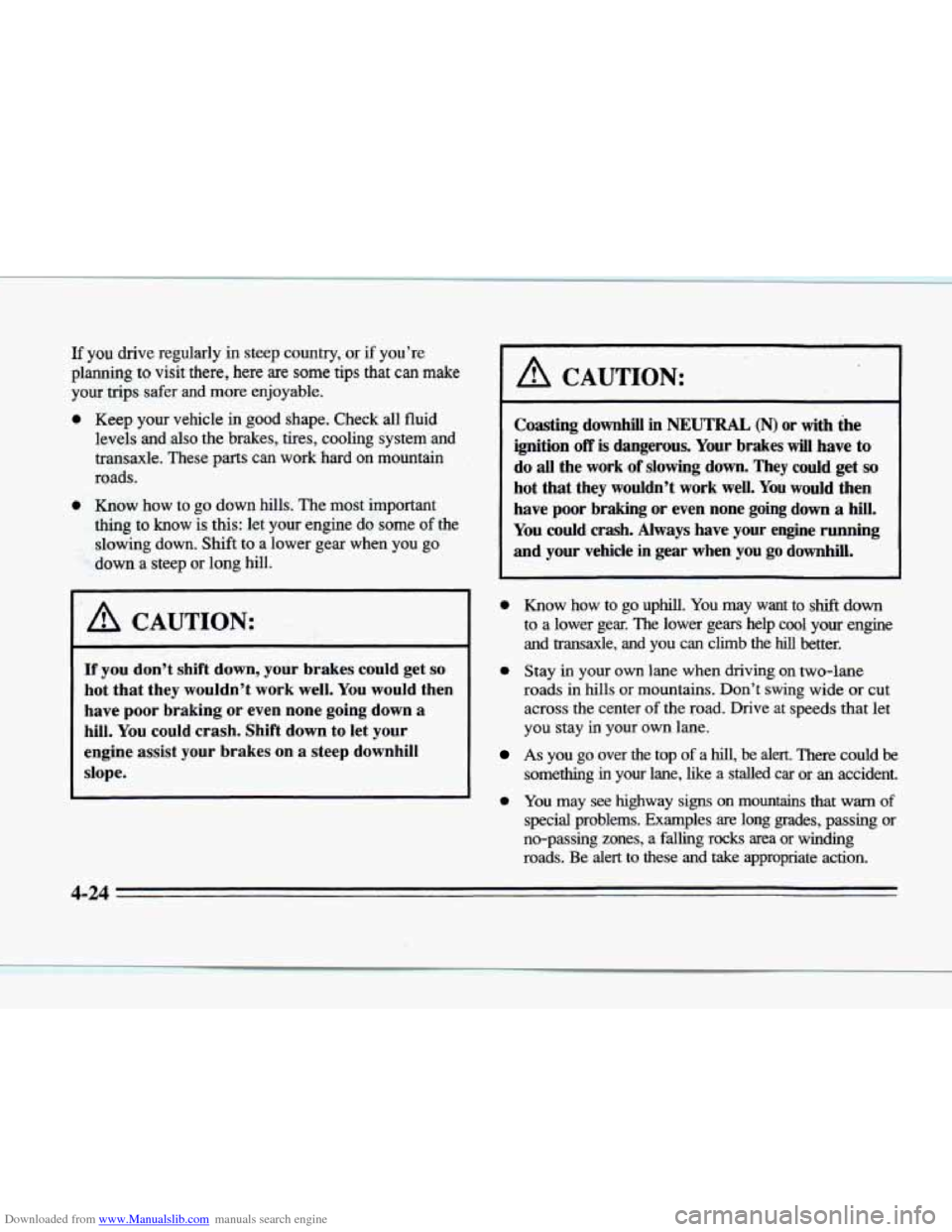
Downloaded from www.Manualslib.com manuals search engine If you drive regularly in steep country, or if you're
planning to visit there, here are some tips that
can make
your trips safer and more enjoyable.
0 Keep your vehicle in good shape. Check all fluid
levels and also the brakes, tires, cooling system and
transaxle. These parts can work hard on mountain
roads.
0 Know how to go down hills. The most important
thing to know is this: let your engine do some of the
slowing down.
Shift to a lower gear when you go
down a steep or long hill.
A CAUTION:
Coasting downhill in NEUTRAL (N) or with the
ignition
off is dangerous. Your brakes will have to
do
all the work. of slowing down. They could get so
hot that they wouldn't work well. You would then
have poor braking
or even none going down a hill.
You could crash. Always have your engine running
and your vehicle
in gear when you go downhill.
" A CAUTION: * '- .. v ',. ' '
If you don't shift down, your brakes could get so
hot that they wouldn't work well. You would then
have poor braking or even none going down
a
hill. You could crash. Shift down to let your
engine assist your brakes on
a steep downhill
slope.
0 Know how to go uphill. You may want to shift down
to a lower gear. The lower gears help cool your engine
and transaxle, and you can climb the
hill better.
0 Stay in your own lane when driving on two-lane
roads in hills or mountains. Don't swing wide or cut
across the center of the road. Drive
at speeds that let
you stay in your own lane.
As you go over the top of a hill, be alert. There could be
something in your lane, like a stalled
car or an accident.
0 You may see highway signs on mountains that warn of
special problems. Examples are long grades, passing or
no-passing zones,
a falling rocks area or winding
roads. Be alert to these and take appropriate action.
4-24
Page 221 of 354
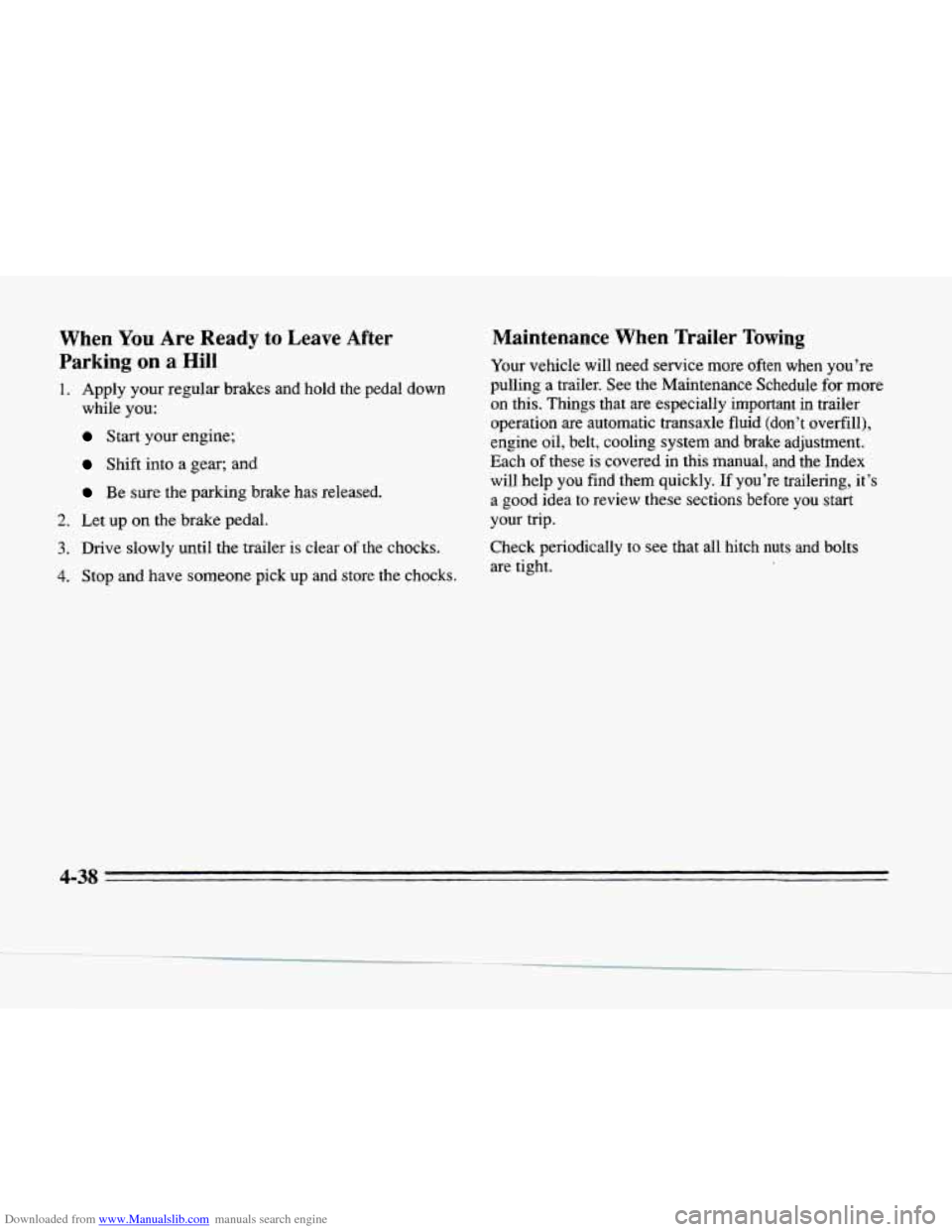
Downloaded from www.Manualslib.com manuals search engine When You Are Ready to Leave After
Parking
on a Hill
1. Apply your regular brakes and hold the pedal down
while
you:
Start your engine;
Shift into a gear; and
Be sure the parking brake has released.
2. Let up on the brake pedal.
3. Drive slowly until the trailer is clear of the chocks.
4. Stop and have someone pick up and store the chocks.
Maintenance When Trailer Towing
Your vehicle will need service more often when you’re
pulling a trailer. See the Maintenance Schedule for more
on this. Things that are especially important
in trailer
operation are automatic transaxle fluid (don’t overfill),
engine oil, belt, cooling system and brake adjustment.
Each of these
is covered in this manual, and the Index
will help you find them quickly. If you’re trailering, it’s
a good idea to review these sections before you start
your trip.
Check periodically to see that all
hitch nuts and bolts
are tight.
Page 265 of 354
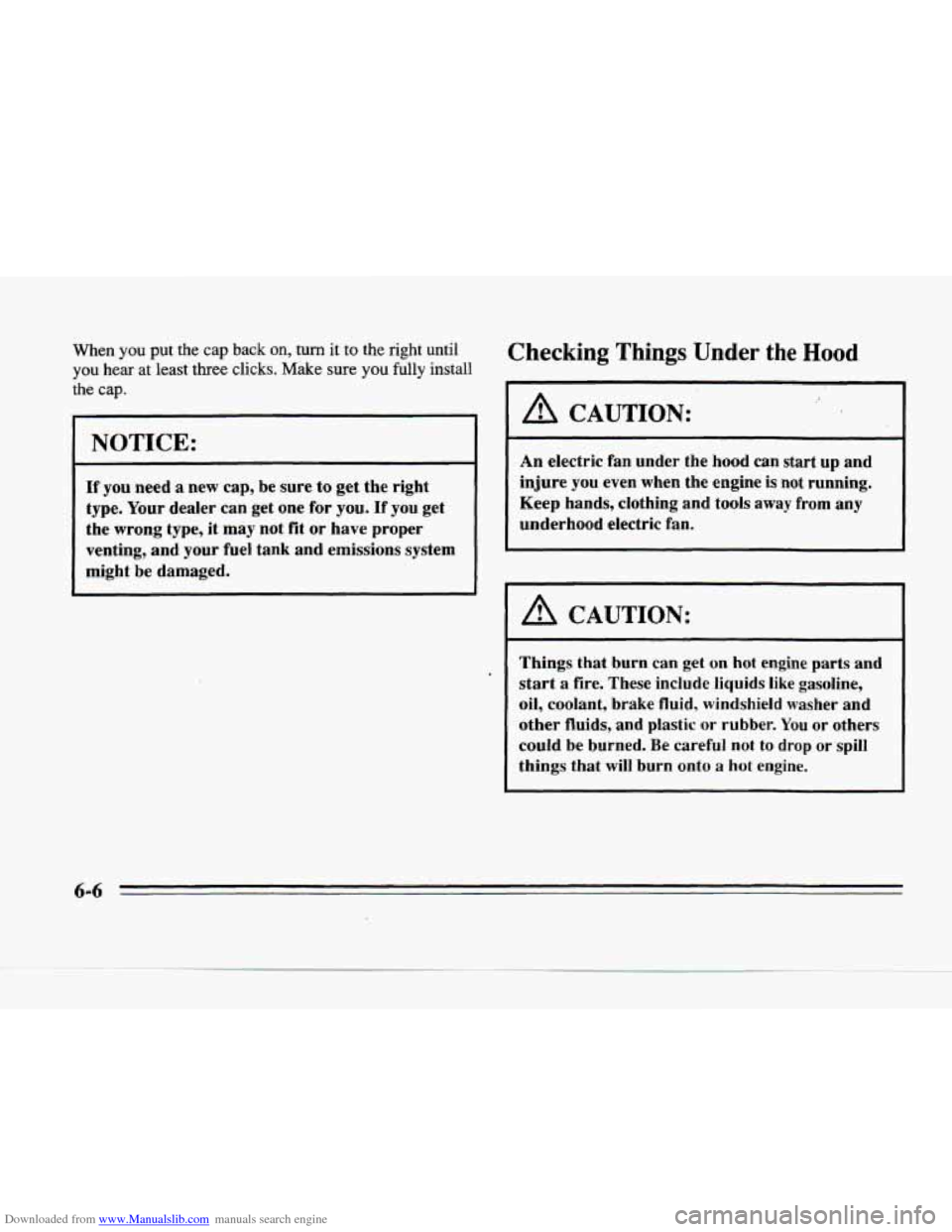
Downloaded from www.Manualslib.com manuals search engine When you put the cap back on, turn it to the right until
you hear at least three clicks. Make sure you fully install
the
cap.
I NOTICE:
If you need a new cap, be sure to get the right
type. Your dealer can get one for you. If you get
the wrong type, it may not fit
or have proper
venting, and your fuel tank and emissions system
might be damaged.
Checking Things Under the Hood
A CAUTION:
..
An electric fan under the hood can start up and
injure you even when the engine
is not running.
Keep hands, clothing and tools away from any
underhood electric fan.
A CAUTION:
Things that burn can get on hot engine parts and
start
a fire. These include liquids like gasoline,
oil, coolant, brake fluid, windshield washer and
other fluids,
and plastic or rubber. You or others
could be burned.
Be careful not to drop or spill
things that will
burn onto a hot engine.
6-6
Page 267 of 354
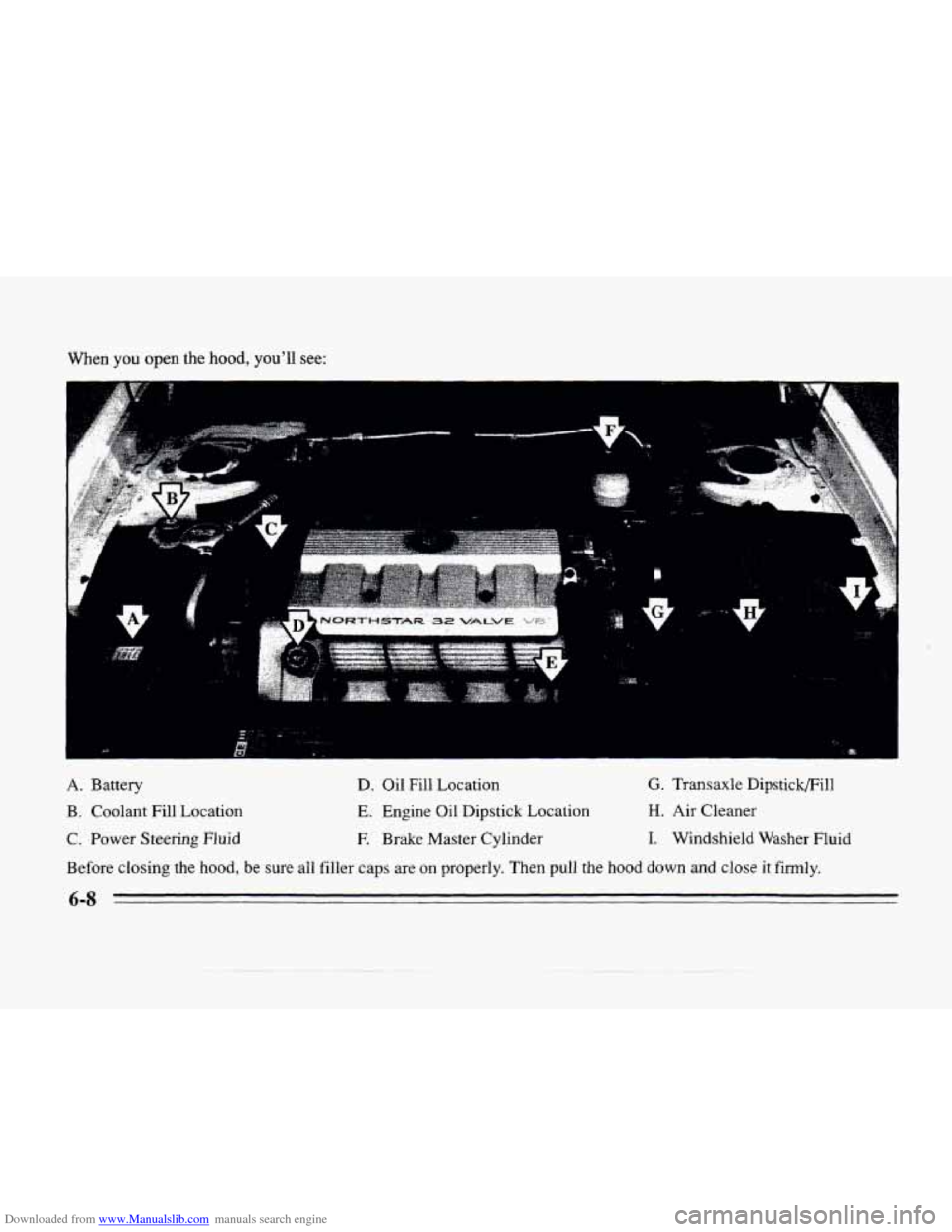
Downloaded from www.Manualslib.com manuals search engine When you open the hood, you'll see:
.. .
A. Battery D. Oil Fill Location G. Transaxle Dipstick/Fill
B. Coolant Fill Location
E. Engine Oil Dipstick Location H. Air Cleaner
C. Power Steering Fluid E Brake Master Cylinder I. Windshield Washer Fluid
Before closing the hood, be sure all filler caps are on properly. Then
pull the hood down and close it firmly.
6-8
Page 277 of 354
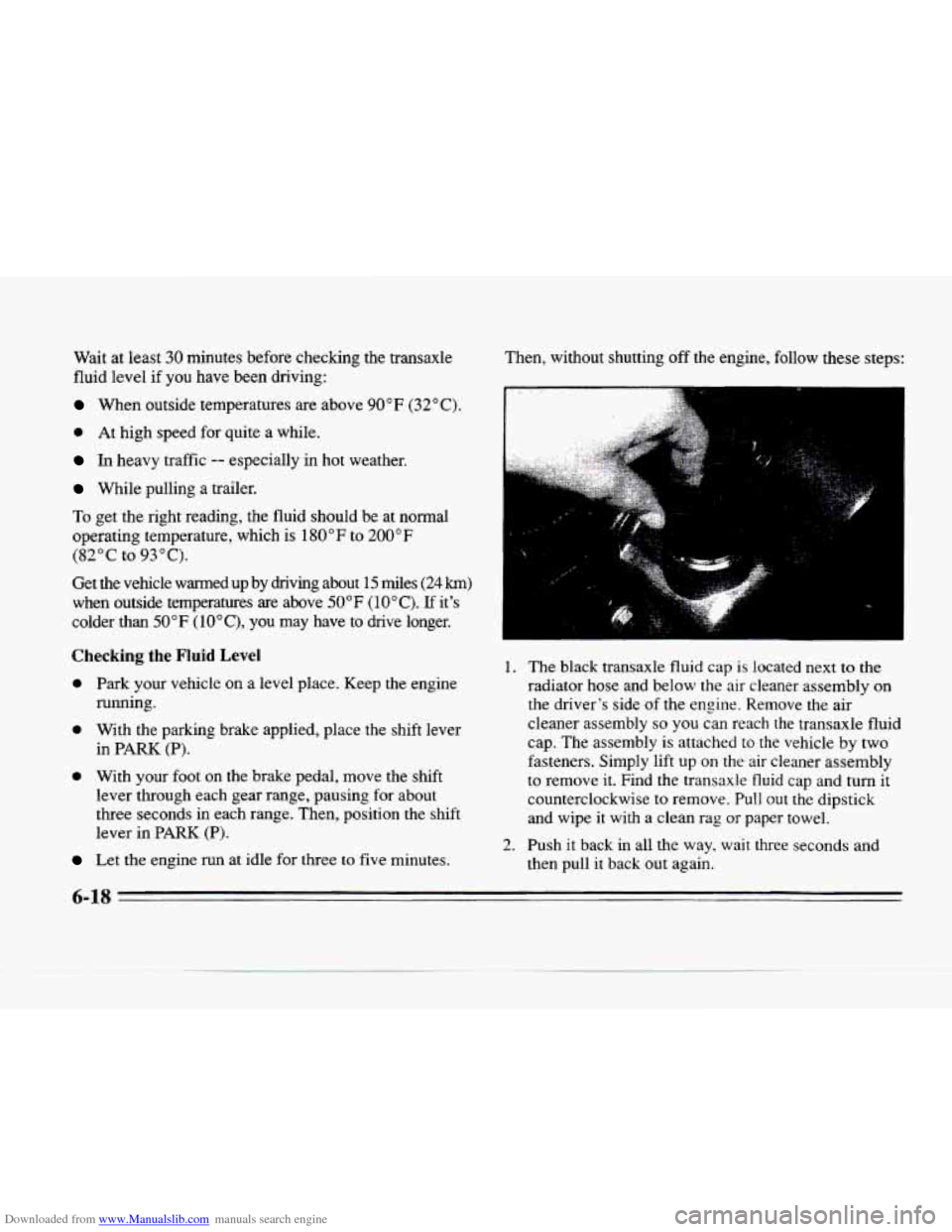
Downloaded from www.Manualslib.com manuals search engine Wait at least 30 minutes before checking the transaxle
fluid level if you have been driving:
When outside temperatures are above 90°F (32°C).
0 At high speed for quite a while.
In heavy traffic -- especially in hot weather.
While pulling a trailer.
To get the right reading, the fluid should be at normal
operating temperature, which is 180 OF to 200 OF
(82°C to 93°C).
Get the vehicle warmed up by driving about 15 miles (24 km)
when outside temperatures are above 50°F (10°C). If it's
colder
than 50°F (lO"C), you may have to drive longer.
Checking the Fluid Level
0 Park your vehicle on a level place. Keep the engine
0 With the parking brake applied, place the shift lever
0 With your foot on the brake pedal, move the shift
lever through each gear range, pausing for about
three seconds in each range. Then, position the shift
lever
in PARK (P).
running.
in
PARK (P).
Let the engine run at idle for three to five minutes. Then,
without shutting off the engine, follow these steps:
1. The black transaxle fluid cap is located next to the
radiator hose and below the air cleaner assembly
on
the driver's side of the engine. Remove the air
cleaner assembly so you can reach the transaxle fluid
cap, The assembly is attached to the vehicle
by two
fasteners. Simply lift up on the air cleaner assembly
to remove it. Find the transaxle fluid cap and turn it
counterclockwise to remove. Pull out the dipstick
and wipe it with
a clean rag or paper towel.
2. Push it back in all the way. wait three seconds and
then pull it back out again.
6-18
Page 285 of 354
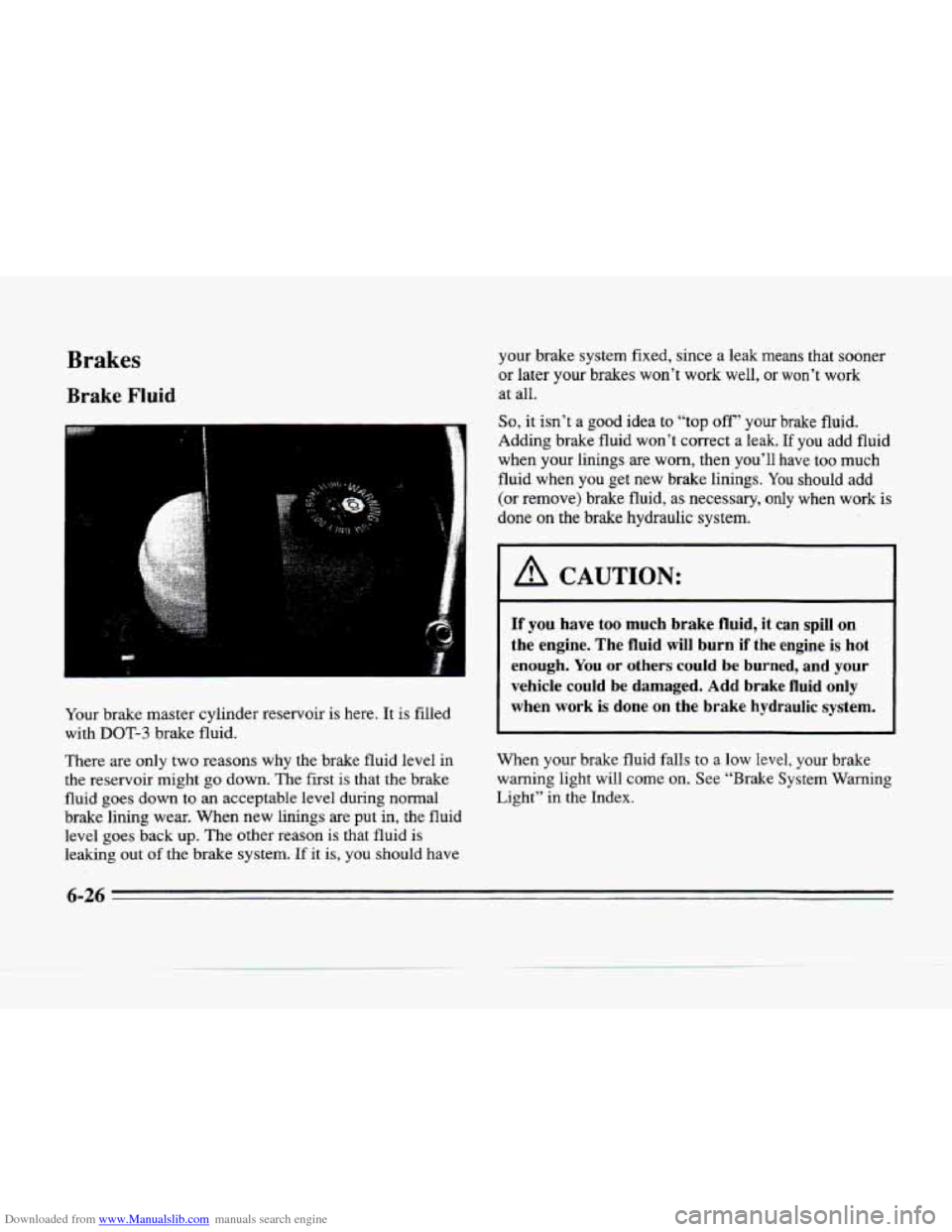
Downloaded from www.Manualslib.com manuals search engine Brakes
Brake Fluid
Your brake master cylinder reservoir is here. It is filled
with
DOT-3 brake fluid.
There are only two reasons why the brake fluid level in
the reservoir might go down. The
first is that the brake
fluid goes down
to an acceptable level during normal
brake lining wear. When new linings are put in, the fluid
level goes back up.
The other reason is that fluid is
leaking out
of the brake system. If it is, you should have your brake system
fixed, since a leak means that sooner
or later your brakes won’t work well,
or won’t work
at all.
So, it isn’t a good idea to “top off’ your brake fluid.
Adding brake fluid won’t correct a leak.
If you add fluid
when your linings are
worn, then you’ll have too much
fluid when
you get new brake linings. You should add
(or remove) brake fluid,
as necessary, only when work is
done on the brake hydraulic system.
I A CAUTION:
If you have too much brake fluid, it can spill on
the engine. The fluid will burn if the engine is hot
enough. You or others could be burned, and your
vehicle could
be damaged. Add brake fluid only
when work
is done on the brake hydraulic system.
When your brake fluid falls to a low level, your brake
warning light will
come on. See “Brake System Warning
Light” in the Index.
6-26
--
Page 286 of 354
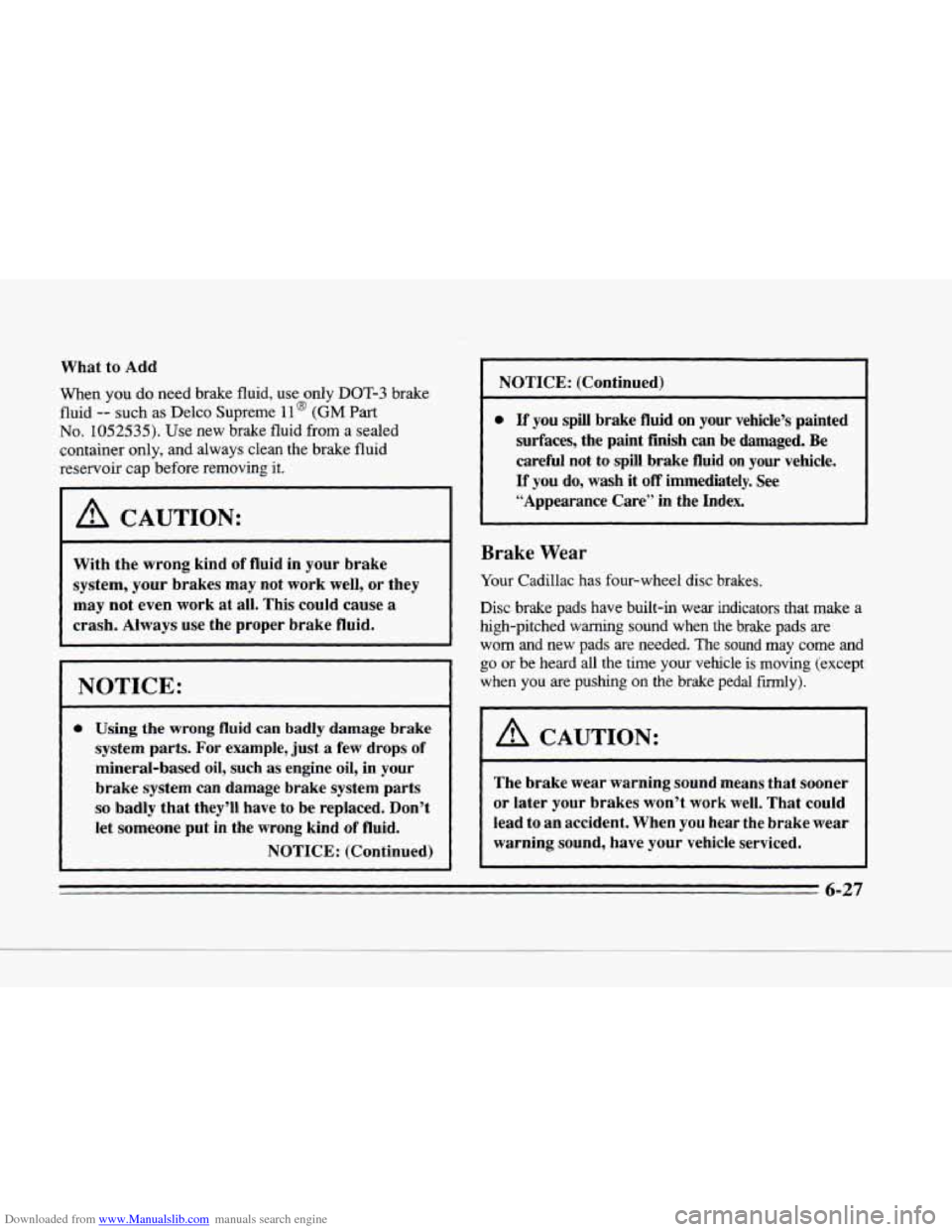
Downloaded from www.Manualslib.com manuals search engine i,
k
c-
What to Add
When you do need brake fluid, use only DOT-3 brake
fluid
-- such as Delco Supreme 11 @ (GM Part
No. 1052535). Use new brake fluid from a sealed
container only, and always clean the brake fluid
reservoir cap before removing it.
I A CAUTION:
With the wrong kind of fluid in your brake
system, your brakes may not work well,
or they
may not even work
at all. This could cause a
crash. Always use the proper brake fluid.
NOTICE:
0 Using the wrong fluid can badly damage brake
system parts. For example,
just a few drops of
mineral-based oil, such as engine oil, in your
brake system can damage brake system parts
so badly that they’ll have to be replaced. Don’t
let someone put in the wrong kind
of fluid.
NOTICE: (Continued)
NOTICE: (Continued)
0 If you spill brake fluid on your vehicle’s painted
surfaces, the paint finish
can be damaged. Be
careful
not to spill brake fluid on your vehicle.
If you do, wash it off immediately. See
“Appearance Care” in the Index.
Brake Wear
Your Cadillac has four-wheel disc brakes.
Disc brake pads have built-in wear indicators that make a
high-pitched
warning sound when the brake pads are
worn and new pads are needed. The sound may come and
go or be heard all the time your vehicle is moving (except
when
you are pushing on the brake pedal firmly).
1 A CAUTION:
The brake wear warning sound means that sooner
or later your brakes won’t work well. That could
lead to an accident. When you hear the brake wear
warning sound, have your vehicle serviced.